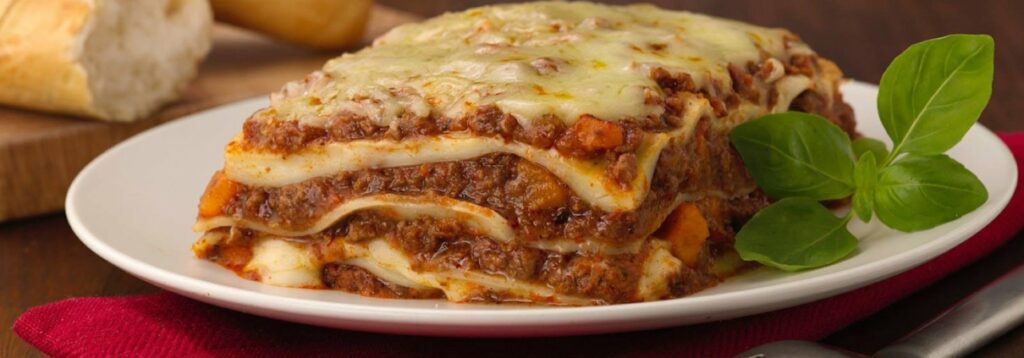Lasagna, one of the most beloved Italian dishes around the world, is more than just layers of pasta and cheese—it’s a heartwarming meal deeply rooted in culinary tradition. Though today it is globally recognized, lasagna’s roots trace back to ancient civilizations and have evolved through centuries.
The term “lasagna“ originates from the Greek word “laganon”, which referred to flat sheets of dough cut into strips. The Romans later adapted the word to “lasanum,” meaning cooking pot. Eventually, the Italians transformed both the name and the dish into what we now know as lasagna.
Modern lasagna, especially the kind made popular in Naples and Bologna, is typically made with layers of pasta sheets, rich meat sauce (ragù), béchamel or ricotta cheese, and grated Parmigiano-Reggiano. Regional variations exist throughout Italy. For instance, in Northern Italy, béchamel is preferred, while Southern Italian recipes lean more on ricotta and tomato-based sauces.
Lasagna has since made its way into kitchens across the globe, especially in America where new adaptations like vegetarian lasagna, seafood lasagna, and even Mexican-inspired lasagna are now common. Despite the many variations, the dish always retains its core appeal—comfort, flavor, and satisfaction in every bite.
How to Make the Perfect Homemade Lasagna
Making lasagna from scratch may seem intimidating, but it’s actually quite manageable—and definitely rewarding. Here’s a step-by-step guide to preparing a traditional lasagna that will impress family and friends.
Ingredients:
For the meat sauce:
- 2 tablespoons olive oil
- 1 onion, finely chopped
- 2 garlic cloves, minced
- 500g ground beef or Italian sausage
- 1 can crushed tomatoes (28 oz)
- 2 tablespoons tomato paste
- 1 teaspoon dried oregano
- Salt and pepper to taste
- Fresh basil (optional)
For the béchamel sauce:
- 4 tablespoons butter
- 4 tablespoons all-purpose flour
- 3 cups milk
- A pinch of nutmeg
- Salt to taste
Other ingredients:
- 9-12 lasagna noodles (boiled and drained, or no-boil type)
- 2 cups shredded mozzarella cheese
- 1 cup grated Parmesan cheese
- 1 cup ricotta cheese (optional)
Instructions:
- Prepare the meat sauce:
In a large skillet, heat olive oil over medium heat. Sauté the onions and garlic until soft. Add the ground beef or sausage and cook until browned. Stir in the crushed tomatoes, tomato paste, oregano, salt, and pepper. Let the sauce simmer for at least 30 minutes to deepen the flavors. - Make the béchamel sauce:
In a separate saucepan, melt the butter. Add the flour and stir to form a roux. Slowly add the milk while whisking continuously to avoid lumps. Cook until thickened, then season with salt and a pinch of nutmeg. - Assemble the lasagna:
Preheat your oven to 375°F (190°C). In a 9×13-inch baking dish, spread a layer of meat sauce on the bottom. Add a layer of noodles, followed by a layer of béchamel and a sprinkle of mozzarella and Parmesan. Repeat the process, ending with sauce and cheese on top. Add dollops of ricotta if desired between layers. - Bake:
Cover the lasagna with aluminum foil and bake for 25 minutes. Remove the foil and bake for another 15–20 minutes or until the top is bubbly and golden. Let it rest for 10 minutes before slicing.
Tips for Success:
- Use fresh pasta sheets if available—they cook faster and have a better texture.
- Don’t overcook the noodles if boiling; they’ll continue cooking in the oven.
- Let the lasagna rest before cutting. This helps it set and hold its shape.
- Experiment with fillings: Spinach, mushrooms, or roasted vegetables make excellent additions.

Modern Variations and Dietary Adaptations
Lasagna is extremely versatile. For those with dietary restrictions or preferences, there are countless creative twists on the classic:
- Vegetarian Lasagna: Replace meat with grilled vegetables like zucchini, eggplant, and bell peppers.
- Vegan Lasagna: Use plant-based cheese and meat substitutes; cashew cream can replace béchamel.
- Gluten-Free Lasagna: Substitute regular pasta with gluten-free noodles or thin layers of zucchini.
- Keto Lasagna: Skip the noodles and layer meat sauce between eggplant or cabbage slices.
Frozen lasagna is also a popular option for busy individuals. While it lacks the homemade charm, it’s a convenient alternative when time is tight.
Conclusion
Lasagnas is more than just a pasta dish—it’s a culinary symbol of tradition, love, and comfort. From its ancient roots to its modern interpretations, lasagna has evolved while maintaining its essence: rich layers, bold flavors, and satisfying textures.
Whether you stick with the classic version or try a creative twist, preparing lasagnas at home brings joy and flavor to any table. With the right ingredients and a little patience, you’ll master the art of lasagnas and understand why this dish continues to captivate hearts and taste buds around the world.
